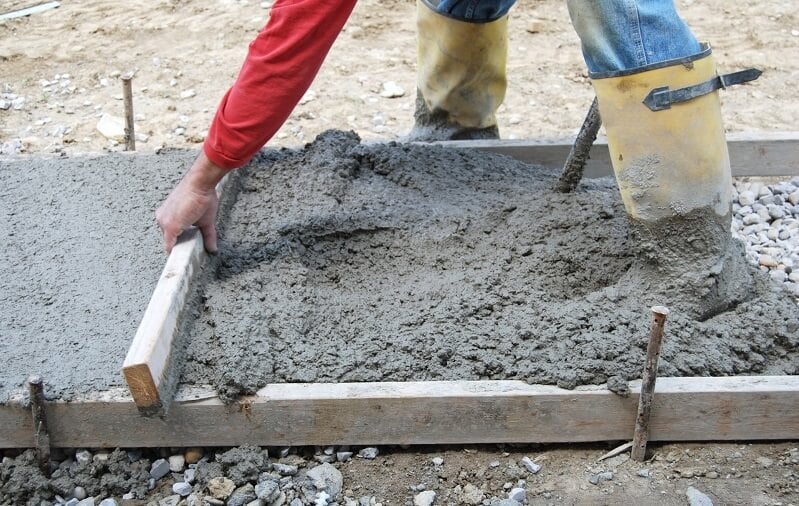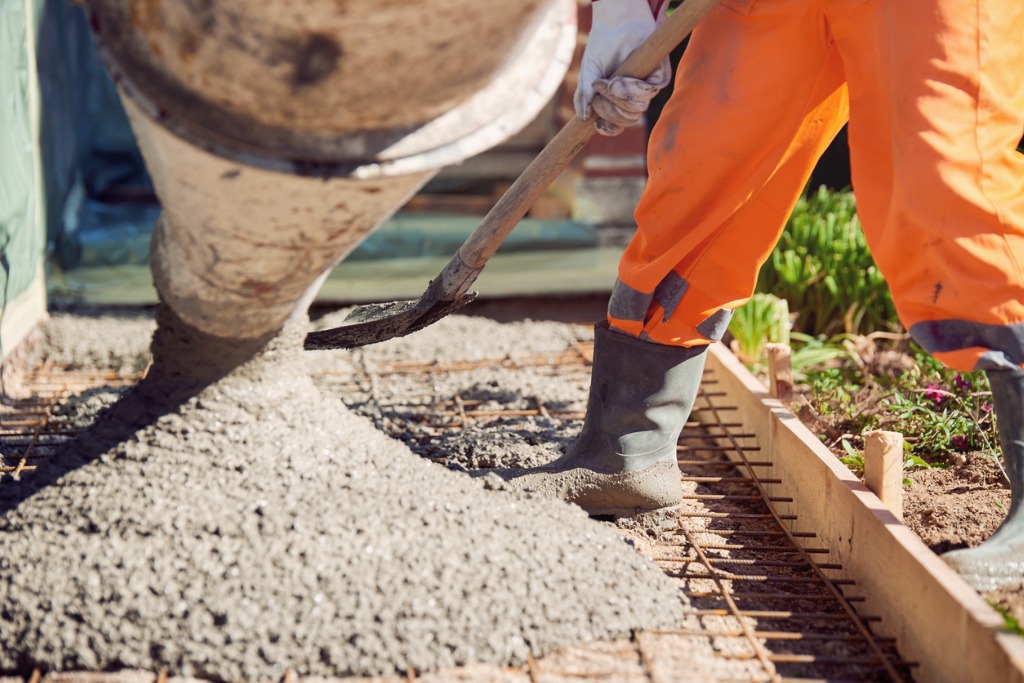What to check when hiring a Concrete Contractor Near Me for your next build
Everything about Concrete: Crucial Services for Residential and Commercial Building
Concrete is a crucial component in the construction market, serving both property and business needs. Its distinct structure supplies stamina and longevity, making it ideal for numerous applications. From fundamental job to decorative finishes, concrete plays a significant role in enhancing architectural honesty and visual charm. Yet, there are numerous nuances to ponder when collaborating with this versatile material. The exploration of its vital services reveals a lot more than satisfies the eye.
Comprehending the Fundamentals of Concrete
Concrete, an essential material in construction, is made up of a blend of cement, water, aggregates, and ingredients. This flexible material is understood for its flexibility, sturdiness, and stamina, making it a preferred option for numerous applications. The concrete works as a binding agent, while accumulations provide mass and stamina. Water is crucial for the hydration procedure, which changes the mix into a solid mass. Ingredients can modify the homes of concrete, such as establishing time and workability, enabling customized services to certain project demands.
Concrete can be cast right into different sizes and shapes, making it appropriate for everything from walkways to high-rises. Its ability to withstand compressive pressures makes it ideal for structural elements. Its thermal mass contributes to energy effectiveness in structures. Understanding these basic aspects of concrete is vital for anybody associated with the construction industry, as it prepares for effective task execution.

Important Concrete Solutions for Structures
Structures play a significant function in the security and long life of any type of framework, and concrete services are essential in their building and construction. A trusted concrete structure warranties that the weight of the building is uniformly dispersed, minimizing the risk of clearing up or shifting. Vital services include site prep work, where the ground is rated and compressed to develop a strong base. Concrete putting complies with, using high-quality products to create a sturdy piece or grounds created to stand up to different environmental conditions.
Support, commonly with steel rebar, includes toughness to the structure, protecting against splits and architectural failings. Appropriate treating methods are likewise necessary, permitting the concrete to attain its ideal strength over time. Additionally, waterproofing steps can be implemented to safeguard against moisture intrusion, which is critical for maintaining the integrity of the structure. These vital concrete solutions collectively add to a durable structure, developing the backbone of any kind of effective building and construction task.
Driveway Setup and Maintenance Options
In the domain name of driveway installment, various materials such as concrete, asphalt, and crushed rock supply distinctive advantages and looks. Comprehending these choices is important for homeowners looking for longevity and charm. Additionally, implementing reliable maintenance methods can greatly prolong the life-span and functionality of a driveway.

Sorts Of Driveway Products
Driveways function as essential paths for automobiles, and the choice of products considerably affects their look, resilience, and upkeep needs. Common driveway products consist of concrete, asphalt, gravel, pavers, and blocks. Concrete driveways are known for their toughness and longevity, while asphalt uses flexibility and a smooth surface. Crushed rock driveways are easy and affordable to install, giving good drain but needing even more maintenance. Pavers and bricks offer aesthetic charm and versatility in style, yet they can be much more labor-intensive to mount. Each material has one-of-a-kind qualities that satisfy various preferences and spending plans, making it crucial for house owners and building contractors to meticulously consider their choices when picking driveway products for industrial or property jobs.
Upkeep Tips for Toughness
Choosing the right products for driveways is just the beginning; reliable upkeep is vital for guaranteeing their longevity and efficiency. Routine cleansing is crucial, as oil, particles, and dust can degrade the surface. Property owners need to take into consideration securing their concrete driveways every couple of years to protect against dampness seepage and freeze-thaw cycles. Cracks ought to be resolved without delay; tiny crevices can promptly expand if left neglected. Furthermore, it is a good idea to stay clear of hefty lots and sharp things that can harm the surface area. Mounting correct water drainage systems can avoid water build-up, which is essential for keeping structural stability. Finally, routine examinations help recognize her comment is here possible concerns early, enabling timely repair services and prolonging the driveway's life-span considerably.
Attractive Concrete Surfaces for Visual Charm
While several associate concrete largely with performance, decorative concrete surfaces have actually arised as a prominent selection for boosting aesthetic allure in numerous construction tasks. Concrete Contractor Near Me. These finishes change regular concrete into aesthetically striking surface areas, ideal for both property and industrial applications. Strategies such as marking, staining, and polishing enable for a variety of shades, structures, and patterns, enabling designers to mimic natural materials like rock or timber
Amongst the numerous choices, stamped concrete provides an affordable way to accomplish elaborate layouts, while acid discoloration adds depth and vibrancy to surface areas. Refined concrete, on the other hand, supplies a streamlined, contemporary look, suitable for contemporary spaces. Additionally, revealed accumulation surfaces can display vibrant rocks, adding a special touch to exterior areas. In general, attractive concrete coatings not only elevate the aesthetic allure of areas but additionally contribute to the longevity and durability of concrete surface areas in a trendy way.
Concrete Repair and Reconstruction Methods
Addressing problems of wear, damages, or degeneration in concrete surfaces is essential for maintaining architectural stability and visual appeal. Different concrete repair work and remediation strategies are used to bring back surface areas to their original condition. Split securing is a common technique, entailing using customized materials to fill and Look At This prevent additional damages. For extra substantial fixings, epoxy injection can be made use of to bond and strengthen fractured areas. Surface spalling commonly calls for resurfacing, where a new layer of concrete is applied to enhance resilience and look. Additionally, concrete overlays supply a reliable service for bring back worn surface areas while using design adaptability. In instances of extreme wear and tear, complete replacement may be essential. Proper assessment and timely treatment are crucial in identifying one of the most reliable repair service method, consequently lengthening the life-span of concrete frameworks and making certain security for business and household applications.
Ecological Factors To Consider in Concrete Construction
Environmental considerations play a crucial role in modern-day concrete building practices. Stressing lasting product choices, effective waste monitoring practices, and strategies for carbon footprint reduction can markedly enhance the eco-friendly effect of construction tasks. As the sector evolves, attending to these aspects ends up being progressively vital for promoting sustainability.
Lasting Material Options
As the building market significantly focuses on sustainability, the expedition of sustainable material alternatives in concrete construction has gained significant focus. Traditional concrete blends usually rely upon Portland cement, which has a substantial carbon footprint. Alternatives such as fly ash, slag cement, and recycled concrete accumulations are being made use of to lower ecological effect. Additionally, bio-based admixtures and innovative techniques like carbon capture and utilization are emerging, further boosting the sustainability of concrete. These products not only reduce waste but additionally boost the efficiency and toughness of concrete frameworks. By integrating sustainable options, the building and construction sector can add to a circular economy, reduce greenhouse gas exhausts, and promote responsible source administration while meeting the expanding need for eco-friendly structure practices.
Waste Monitoring Practices
Properly handling waste is vital in concrete building, where significant products can be lost throughout manufacturing and demolition processes. Applying robust waste monitoring methods not only preserves resources browse around this site yet likewise decreases environmental influence. Reuse and recycling of concrete debris are crucial strategies, making it possible for the recovery of accumulations for brand-new mixes. In addition, proper sorting of products at work sites can reduce contamination and rise recycling rates. Making use of lean construction techniques better improves performance by optimizing material use and decreasing excess waste. Education and training of employees in effective waste management practices ensure adherence to standards, fostering a culture of sustainability. Generally, these methods add to a more ecologically liable approach in the concrete industry, supporting both commercial and domestic jobs.

Carbon Impact Reduction
Waste administration techniques established the phase for addressing the carbon impact connected with concrete construction. The manufacturing of concrete is recognized to produce significant greenhouse gas emissions, mainly from concrete manufacturing. To minimize this effect, numerous strategies have emerged. Utilizing alternate materials, such as recycled aggregates and commercial spin-offs like fly ash, helps in reducing dependence on typical cement. Developments in concrete solutions, including the advancement of low-carbon and carbon-absorbing concrete, contribute to sustainability goals. Implementing energy-efficient methods in blending and healing processes additionally plays a necessary function. In addition, optimizing transport logistics decreases exhausts associated with providing concrete. By taking on these actions, the building sector can significantly reduce its carbon footprint while advertising environmentally friendly practices.
Regularly Asked Concerns
The Length Of Time Does Concrete Require To Treat Completely?
Concrete generally takes 28 days to heal completely, reaching its perfect stamina (Phoenix Concrete Contractor). First setup happens within hours, and it can support light lots after a couple of days, depending on environmental conditions and blend structure.

Can I Pour Concrete in Cold Weather?
Yes, concrete can be gathered winter, but safety measures are essential. Proper insulation, using warm water, and additives can help guarantee sufficient treating and stop cold, which might endanger the stability of the concrete.
What Is the Ordinary Lifespan of Concrete Frameworks?
The typical life expectancy of concrete structures normally ranges from 30 to 100 years, depending upon aspects such as environmental conditions, maintenance practices, and the top quality of materials made use of in building and construction.
Is Concrete Recyclable After Demolition?
Yes, concrete is recyclable after demolition - Phoenix Concrete Contractor. It can be smashed and repurposed for numerous applications, such as brand-new building and construction, roadway base, and landscaping. This process helps minimize waste and saves natural deposits
Exactly how Do I Select the Right Service Provider for Concrete Work?
To choose the ideal service provider for concrete job, one should confirm qualifications, examine previous tasks, read reviews, and obtain numerous quotes. Clear interaction concerning job assumptions and timelines likewise plays an essential function in the choice process.
Concrete, a fundamental product in building and construction, is composed of a blend of concrete, water, accumulations, and additives. While numerous associate concrete largely with capability, attractive concrete coatings have arised as a prominent selection for improving visual charm in different construction projects. As the building and construction industry progressively focuses on sustainability, the exploration of lasting material choices in concrete building and construction has acquired substantial attention. Successfully taking care of waste is important in concrete building and construction, where significant materials can be lost during production and demolition procedures. Innovations in concrete formulations, including the advancement of carbon-absorbing and low-carbon concrete, add to sustainability goals.